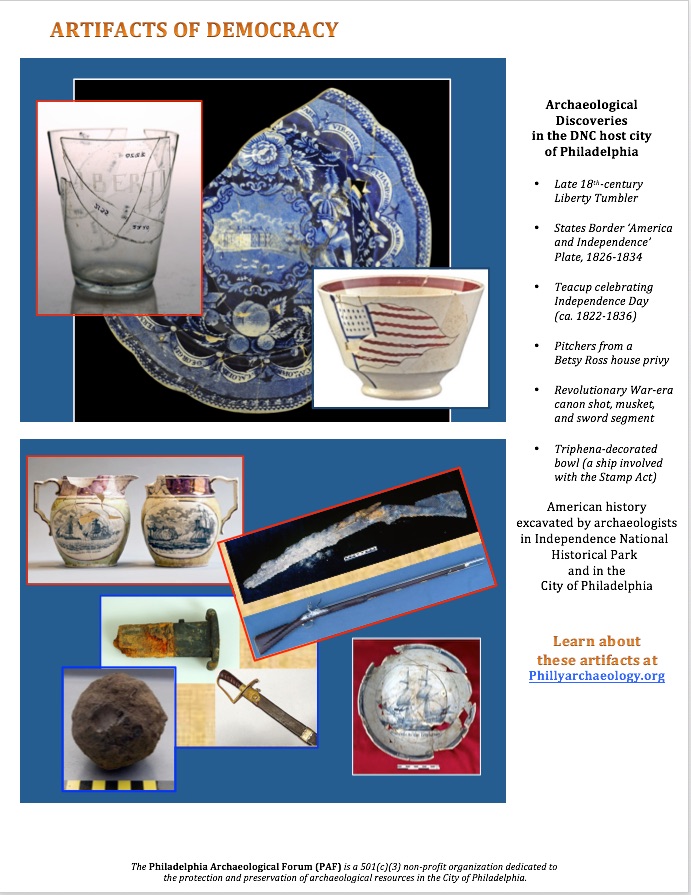Patrice L. Jeppson – A Day of Archaeology, 2016
Back to PAF Home
Back to 2016 Philadelphia Day of Archaeology Index
Back to Philly Day of Archaeology Main Page
~~~
ARTIFACTS OF DEMOCRACY:
ARCHAEOLOGY IN THE DNC HOST CITY, PHILADELPHIA
by Patrice L. Jeppson, Ph.D.
Philadelphia, Pennsylvania, USA
My Day of Archaeology is unique this year as the United States Democratic National Convention (DNC) is taking place in my city, Philadelphia, Pennsylvania. The streets have been filled for days with delegates going to and from convention venues, ultimately casting votes on behalf of the nation’s Democratic Party voters for either Bernie Sanders (my own personal hope) or Hillary Clinton (the resulting nominee). At the same time, the city is brimming with engaged and often enraged Sanders supporters, anti-Clinton and pro-Donald Trump protesters (very few of both really), and boosters/advocates (MANY) calling attention to any number of causes such as the need for Clean Energy, Climate Change action, Black Lives Matter, Economic Inequality, immigration reform, and establishing a federal legalization of marijuana. This is serious advocacy and demonstration going on –but it often also has a very festive feel to it with, for example, a 50 foot inflatable joint carried around by 25 people that walked down my street and a man with an alpaca — the mascot for an organic farming cause — that ate some of our flowers in front of the house. My cause during this period –beyond thanking Bernie Sanders and his supporters — has been to target DNC visitors to Philadelphia with a public archaeology campaign highlighting some of the ‘Artifacts of Democracy’ that archaeologists have excavated in our city.
This outreach effort involves a social media campaign undertaken as part of the Philadelphia Archaeological Forum, a local archaeology concern of which I am a member, and for whom I collate a local version of the International Day of Archaeology blogging project. I am the webmaster and Facebook manager for PAF. My own academic research involves studying how the public uses local Philadelphia archaeology sites for the needs of national and social identity.
The DNC social media campaign began earlier this week with the creation of a web page dedicated to ‘Artifacts of Democracy’ that was linked to through postings made at numerous city, national park, and DNC-related Facebook pages. Today, the Day of Archaeology, I monitored and analyzed the Facebook results for likes and shares trying to learn ‘where is the archaeology of democracy outreach campaign being seen? who is sharing it? and where are they sharing it to? That was done first thing this morning.
After that I spent several hours interpreting archaeology to the delegates and their families, and to regular summer tourists, who were visiting the site of the President’s House in Independence National Historical Park. The President’s House site, excavated in 2007, is where the first US President, George Washington, served most of his administration, bringing as many as nine enslaved Africans with him from his Virginia home to this ‘Executive Mansion’ in Philadelphia. The site contains the evidence of the precursor to the Presidential Oval Office and bears witness to the original sin of slavery at the birth of the USA in the foundations of structures lived and toiled in by the enslaved Africans. Beyond interpreting the site (something I had done on site during the excavation), I handed out a flier tied to the “Artifacts of Democracy” webpage previously mentioned.
In preparation for this week I had attended an advocacy training session for non-profits to make sure that targeting delegates (many of whom are legislators) during electioneering didn’t violate our group’s non-profit status. At that training I was advised to create three theme statements to provide to the visitors – many of whom would be press people from around the world. I did this: a) Archaeology is an authentic touchstone to the past used by people in the present for establishing social identity, b) archaeology in Philadelphia (the US nation’s birthplace) is the evidence of the real “we the people” (‘us’ back then), c) heritage tourism — based largely on Philadelphia’s archaeology sites — is the primary factor in the city’s economic engine. These are all things that are part of any local archaeology interpretation, along with a LOT of other information, and are things that are usually common to archaeology found elsewhere.
In 2007, I helped to interpret this particular site to literally hundreds of thousands of people but have not been back for a concerted interpretive mission until today. In my studying of the public archaeology at this place I have often referenced the civil religious nature of the site. Standing at the site today I had this realization that the advocacy training I had was directed at ‘trying to take the site’s possibilities out to broader society’. However, as before, the people I was talking to wanted to take themselves into the past at the site. Helping the visitors who were already trying to build a bridge linking the past to their present was what the archaeologist was being asked for. There was a disjuncture with my ‘new’ preparation that I am trying now to analyze. This was only a few hours ago and I am still mulling over this mismatch of formal advocacy training advice verses what we archaeologists are learning about the public’s needs on-site during civic archaeology engagement.
Patrice L. Jeppson, Ph.D.
Webmaster, Philadelphia Archaeological Forum
Adjunct Assistant Professor of Anthropology
Cheyney University of Pennsylvania
This blog entry can also be read as part of the International Day of Archaeology Blogging Project here…
by admin

